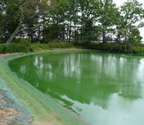 The Centers for Disease Control and Prevention (CDC) published a case study on Wisconsin’s use of partnerships to help build and sustain Harmful Algal Bloom (HAB)-related illness surveillance.
The Centers for Disease Control and Prevention (CDC) published a case study on Wisconsin’s use of partnerships to help build and sustain Harmful Algal Bloom (HAB)-related illness surveillance.
This case study is part of a CDC toolkit for public health professionals designed to encourage HAB surveillance and reporting to One Health Harmful Algal Bloom System (OHHABS).
From the case study –
“The program started in 2008 as part of CDC’s Harmful Algal Bloom Illness Surveillance System (HABISS) project. As one of 10 pilot states participating in the HABISS project, Wisconsin carried out its activities through a core partnership consisting of the Division of Public Health (DPH) in Wisconsin’s Department of Health Services (DHS), the Department of Natural Resources (DNR), and the State Laboratory of Hygiene (WSLH).
“The HABISS project ended in 2013, but DPH found a way to maintain active surveillance for HAB-related illnesses and build upon the existing HAB program infrastructure and agency partnerships.”
Case Study: Building Partnerships for Wisconsin’s Harmful Algal Blooms Program
More Information on Harmful Algal Blooms and Blue-Green Algae
CDC Case Study – https://www.cdc.gov/habs/pdf/hab-partnerships-WI-case-study.pdf
Wisconsin Department of Health Services — https://www.dhs.wisconsin.gov/water/bg-algae/index.htm
Wisconsin Department of Natural Resources — http://dnr.wi.gov/lakes/bluegreenalgae/
Wisconsin State Laboratory of Hygiene – https://www.slh.wisc.edu/testing-for-cyanobacteria-and-blue-green-algae-toxins/ and https://www.slh.wisc.edu/environmental/toxicology/other-analyses/
